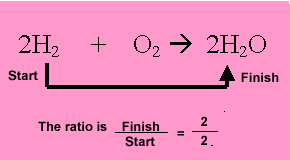Stoichiometry
As we mentioned earlier, stoichiometry is simply a chemical recipe. We can work out how much reactant (ingredient) is required to form a certain amount of product. Stoichiometry relies on one major factor, a balanced chemical equation. From this balanced equation we derive the chemical ratio. The chemical ratio tells us the amount of product that is formed per amount of reactant used.
It sounds very complex, but its not, so lets go to an example just to simplify matters.
|
Hydrogen and oxygen react to form water according to the equation
below |
|
|
Step 1 We identify the starting point in the equation. This is always the point that we can calculate an amount of substance. In this case we know we have 10 moles of hydrogen gas. |

|
|
Step 2 Identify the finish. Step 4 Multiply the ratio by the number of moles given at the start. ratio X start = moles of water produced. 1 X 10 moles of hydrogen = 10
moles of water |
|